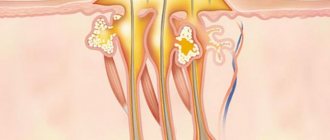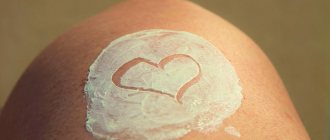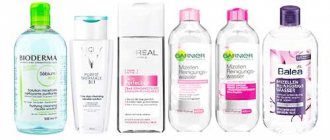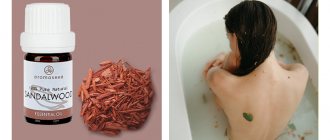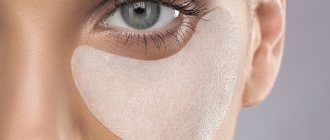What is the mechanism of drug action
The ointment has 3 main effects. It promotes tissue healing, affects metabolism and relieves inflammation. After contact with the wound area, the active substance interacts with the main proteins, for example, albumin. The active substance is involved in processes such as carbohydrate and lipid metabolism, the formation of hormones, mediators and porphyrins. "Dexpanthenol" has a regenerative effect not only on tissues, but also on mucous membranes. The drug also helps stabilize cellular metabolism and accelerate cell mitosis. Elimination is very fast.
Cream "Dexpan Plus" for dry skin care
Peeling, irritation and redness are not all that a person may experience with dry skin.
Much more unpleasant are itching, scratching and cracks - manifestations of xeroderma (the scientific name for dry skin), which increase the risk of contracting a bacterial or fungal infection. In addition, dry skin ages quickly and reacts sharply to sunlight, wind and low air temperatures.
Products used to care for dry skin should help soften, restore and moisturize the skin, protect, and in case of cracks, help restore the barrier function of the skin. To care for your skin during the day, it is preferable to use water-based creams that are quickly absorbed and leave no residue. It is better to apply fatty creams and ointments in a thick layer before bedtime.
Products containing lactic, malic, salicylic acid, resorcinol, urea or allantoin have keratolytic (exfoliating) properties. They soften and painlessly remove dead scales from the skin. In addition, allantoin, a natural compound found in the roots of the plant Symphytum officicale (Comfrey), has a softening and moisturizing effect, stimulates the regeneration and renewal of epidermal cells, eliminates flaking of the skin, making it smooth and elastic.
Moisturizing components create a hydrophobic film on the surface of the skin that prevents moisture evaporation. These include vegetable and animal fats, which also contain vitamins. The most popular components of moisturizing creams are olive, sunflower, flaxseed, sea buckthorn oil, jojoba, argan and avocado oils, and Shea butter.
Humidification creates the necessary conditions for nutrition and regeneration: cells saturated with water, unlike dry and damaged ones, are able to normally perform their functions, including carrying nutrients, oxygen and building new elements. Special nourishing creams contain complexes of vitamins A, B, C, PP, E and others. In addition, for example, provitamin B5 (panthenol) promotes the healing of small wounds, maintains water balance and skin resistance to external environmental influences, and stimulates skin regeneration.
It is not always possible to find a skin care product that contains the full range of properties important for dry and damaged skin.
Cream "Dexpan Plus" - contains a combination of dexpanthenol, allantoin, as well as emollients including shea butter (shea butter), designed to care for dry and damaged skin from the first days of life.
The cream contains components that restore, soften and moisturize the skin. It does not contain aromatic substances or dyes and is hypoallergenic. The cream is quickly absorbed, suitable for delicate areas with sensitive thin skin, does not leave greasy stains, has no odor, which indicates good organoleptic properties and its high compliance.
Cream "Dexpan plus" from Dr. Reddy's was developed by dermatologists specifically for dry and dehydrated skin.
Thanks to the combination with Dexpanthenol, Allantoin and Shea butter, the cream helps restore the skin's protective barrier, softening and moisturizing, eliminating the feeling of dryness and tightness.
Dexnanthenol enhances the skin's ability to retain moisture and soothes particularly dry areas of the skin, Allantoin activates microcirculation of moisture in skin cells. Shea butter has a softening and moisturizing effect, which makes it indispensable for caring for dry and irritated skin.
It should be noted that the cream is well absorbed and does not leave a greasy film on the skin. The formula with panthenol strengthens the skin's protective barrier, preventing moisture loss and soothing irritated areas of the skin.
Prepared based on
1. Sirmais N.S., Tsykin A.A., Kuznetsova Yu.K. Skin xerosis. Solving the problem with external means. RMJ. 2015;9:496
2. Belousova T.A., Kail-Goryachkina M.V. A personalized approach to the selection of basic therapy for dry skin. Con med. 2017;(2):38-42
3. Leaflet cream “Dexpan plus”
Related product: [product](DEXPAN PLUS CREAM 30.0)
As an advertisement
When to use
"Dexpanthenol" is most often used to accelerate healing for minor microtraumas. Can be used on mucous membranes in the presence of erosions. The drug helps fight dry and cracked skin and is indicated for burns and minor abrasions. Sometimes the ointment is prescribed to patients with bullous dermatitis, suppuration and trophic ulcers. It is allowed to be used for the treatment and prevention of bedsores in bedridden patients. The ointment is applied to aseptic wounds for transplantations that do not take root well after operations, but constant monitoring by the attending physician is required.
Dexpanthenol
Dexpanthenol is included in the list of allopathic drugs. In mesotherapy it is used when working with those areas of the face and head where vegetation is observed.
Application specifics:
It has a stimulating effect on regeneration processes in tissues and thus accelerates the transport of fibroblasts to the wound area. As an additional component to meso-cocktails, it acts as a humectant and antioxidant. When it enters the skin canal, it is almost instantly absorbed and combines with plasma proteins.
The drug is indispensable where aesthetic defects are identified. To a greater extent, it is prescribed to patients who have cosmetic problems. These include:
- signs of acne (skin rashes);
- significant hair loss (baldness);
- increased level of skin greasiness;
- loss of former volume, dullness;
- obvious signs of photoaging;
- dermatitis (seborrheic).
How to use: options
Dexpanthenol (second name: panthenol) is a widespread component that manufacturers use everywhere in the manufacture of various serums, emulsions and gels. It has the amazing ability to attract moisture molecules and keep them at the proper level for a long time. Due to its low molecularity, it easily manages to penetrate the skin microchannels in order to stabilize the water balance.
The world's leading manufacturers of cosmetics almost universally include dexpanthenol in their products: hair conditioners, moisturizing masks and nourishing shampoos. By the way, this component acts in a complex manner, namely: first it envelops each hair with an invisible protective film and at the same time, penetrates the hair follicle deeply enough and fills the resulting gaps.
The results from using panthenol are simply amazing! Your hair becomes shiny and smooth, and not only acquires a healthy shine and life, but also acquires protective properties that can withstand the external influence of ultraviolet rays and harsh salts.
Please note that during the procedure using a mesoscooter device, it is permissible to apply dexpanthenol as a stand-alone drug or in combination with other substances, for example, the same hyaluronic acid.
Dosage of the drug: provitamin B5 is consumed at the rate of 1–2 ml on the facial area (hairy part) and exactly 6 ml when working with the body.
Correct use of the drug: guidelines for action
First: Carefully remove the equipment from the container and treat it with an alcohol solution.
Second: Clean the surface of the skin from excess cosmetics, then wipe it with an alcohol-containing lotion.
Third: Fill a sterile syringe with a solution of dexpanthenol and apply it dropwise to the forehead area.
Fourth: Perform smooth movements with the device: 5-10 times: first vertically, then horizontally, and diagonally.
Fifth: Repeat the sequence of actions on the temporal and nasal areas, cheeks, around the eyes, as well as the chin and above the upper lip.
Upon completion of the procedure, apply a moisturizing mask to the irritated areas of the skin and a second layer of sunscreen.
Disinfect the device, dry it well and put it in a box.
Recommendation: it is advisable to carry out procedures with dexpanthenol once every 15 days over the next 6 months. To consolidate the effect obtained, sessions must be continued, but the frequency reduced: 1 time, but every 3 months.
Precautionary measures: The shelf life of an open bottle of the drug in the refrigerator should not exceed 14 days.
Contraindications:
With all its positive properties, dexpanthenol can provoke allergic reactions, which is why it is so important to perform preliminary testing and make sure that you are not at risk. Your actions: a few hours before the procedure, apply a few drops of the product to the inside of your wrist. Watch. If no reactions occur at the site of application of the drug, then we can safely say that you do not have an allergy.
Similar articles
Troxerutin for skin care
· Meliloto in cosmetology
· Centella asiatica in cosmetology
Witch hazel in cosmetology
· Ginkgo biloba in cosmetology
· Organic preparation dimethylaminoethanol (DMAE)
Return to list
How to use for pregnant women and children
Use in children is no different from adults.
The ointment is approved for use by pregnant and lactating women. For treatment in the breast area around the areola in women during breastfeeding, Dexpanthenol is recommended in the form of compresses. Before starting feeding, it is necessary to remove the remaining ointment with running water, without using soap, which can dry out the treated area.
"Dexpanthenol" is also necessary for restoring the skin from diaper rash in newborns.
The use of dexpanthenol ointment in the treatment of diaper dermatitis in newborns
To this day, the problem of treating diaper dermatitis (ND) remains relevant. Its manifestations are observed in almost every infant [2, 5, 7], which determines the need to improve methods of its treatment. When exposed to unfavorable factors (mechanical, chemical, infectious), rapid damage to the skin occurs with the development of inflammatory reactions of varying severity. It is known that the protective function of the skin of a newborn, especially a premature and immature child, is insufficient. This is primarily explained by its anatomical and physiological characteristics (thin surface layer - epidermis, rich vascularization, tendency to proliferative reactions), which determines its easy vulnerability. In addition, the insufficiency of local immunity is important. A feature of the structure of the skin is the absence of elastic fibers, which are formed only by the 2nd year of life. Protection from mechanical damage in a newborn is to some extent provided by the large amount of moisture contained in the stratum corneum of the skin. It has been established that increased moisture in the child’s skin and fecal enzymes, mainly protease and lipase, cause the development of PD, that is, changes in the skin in the area of contact with the diaper. According to modern views, PD is a periodically occurring pathological condition provoked by exposure of the child’s skin to mechanical (diaper fabric), physical (humidity and temperature), chemical (ammonia, digestive enzymes, bile salts) and microbial factors acting inside the diaper or diaper [3]. The influence of these unfavorable factors makes the skin of children easily vulnerable and prone to inflammation [1, 6].
PD is manifested by redness, infiltration of the skin, the appearance of rashes, peeling, erosions, which is accompanied by anxiety in the child and adversely affects his general condition. The disease is more common in children with an allergic mood, which is explained by their predisposition to exudative changes and dyspeptic symptoms. Children who are breastfed are less susceptible to this disease because their feces have lower enzymatic activity. For local treatment of PD, various creams and ointments based on zinc and talc are used, which, due to their adhesive properties, protect the skin from constant exposure to urine and feces [8]. Until recent years, pediatricians did not have an equally effective and safe remedy for the treatment of skin diseases, acting locally and at the same time enhancing regeneration processes at the cellular level.
Dexpanthenol ointment (Bepanten) is a product for external use that stimulates epithelization of the skin and has an anti-inflammatory effect. The active principle of the ointment is provitamin D-pantothenic acid, which is a component of the vitamin A coenzyme, which promotes the growth of the epidermis [4]. An increase in the need for this acid is noted with damage to the skin and tissues. D-pantothenic acid stimulates the function of the adrenal glands, it is necessary for the formation of antibodies, promotes the growth and regeneration of the skin. An increased need for pantothenic acid is observed in the body during destruction or damage to tissues and skin. Its deficiency can be compensated for by local application of dexpanthenol ointment. The properties of newborn skin make it especially important for the drug to penetrate it slowly and deeply due to its hydrophilicity, low molecular weight and low polarity. Purpose of the study: to evaluate the effectiveness of the use of dexpanthenol ointment (Bepanten) in the treatment of PD in newborns. The study was conducted in the department of pathology of newborns and premature babies (department of the second stage of nursing) of the clinic of childhood diseases of the State Budgetary Educational Institution of Higher Professional Education “First Moscow State Medical University named after I.M. Sechenov." There were 48 children under our supervision - 25 boys, 23 girls. The majority of children (78%) were born full-term. The main diagnosis in all patients was perinatal CNS damage. All children showed manifestations of PD.
When analyzing the health status of the parents, it was revealed that 40% of the examined children had a family history of allergies, and in more than half of these children both parents suffered from allergic diseases. In the course of ongoing research, the dependence of the incidence of PD on the type of feeding was established. PD occurred 5 times more often in children who were bottle-fed compared to children who received breast milk. In 93% of newborns, PD occurred against the background of pathological stool (liquefaction, undigested lumps, mucus, green color), which was regarded as a manifestation of intestinal dysbiosis. In the coprograms of most children, an increase in the content of neutral fat and soap was noted. A bacteriological examination of stool revealed no pathogenic microorganisms or fungi. The severity of skin changes was assessed according to the traditional classification (F. Germozo, 1984). In 16 (53%) of the examined patients, PD of moderate severity was diagnosed, which was manifested by the development of erythema, papules, erosions, infiltrates in the skin folds, dryness, and peeling of the skin. 14 (47%) children had a mild degree of PD in the form of erythema of varying prevalence. In 100% of cases, PD developed in the buttocks; in addition, 7% of children also had skin lesions on the genitals and 10% on the thighs (Fig. 1–3). In children with allergic manifestations, PD had a recurrent course.
At the first manifestations of PD, Bepanten ointment was prescribed. The ointment was applied daily in a thin layer to the affected skin of the child during swaddling 4–5 times per day. In most patients, improvement was noted on the 2nd day. Treatment with Bepanten continued until the skin changes completely disappeared. In the group of children with mild severity of the disease, the average duration of treatment was 4.2±0.7 days, in the group of children with moderate severity of PD - 4.7±0.6 days. There was no significant difference in the duration of treatment for moderate and mild forms of PD (p>0.05). A positive effect - recovery - was noted in 100% of cases (other topical medications were not used). There were no side effects when using dexpanthenol ointment; the children tolerated the drug well. The clinical effect was best when, after the acute period, the use of the ointment continued for another 2–3 days. This was especially true for children with a history of allergies.
It should be noted that in caring for patients with the development of PD, only modern disposable diapers were used, containing moisture-absorbing gel-forming materials in the inner layer, which reduced the squeezing of moisture from the diaper onto the skin (while the pH level of the skin approached normal), and prevented skin contact with secretions ( feces and urine), which led to a decrease in the exposure of the skin to ammonia, which is released when feces interact with urine and irritates the baby’s delicate skin, and also reduced the irritating effect of fecal enzymes on the skin.
Modern diapers provide close to normal skin moisture and pH levels, therefore, their use reduces the spread and severity of PD. Cosmetics for cleansing the skin (soap, bathing foam, wet wipes) were selected individually for each child. The main criterion was their good tolerability. Thus, studies have shown that dexpanthenol ointment (Bepanten) is an effective and safe treatment for PD in newborns. It should be noted that there are no side effects and the drug is well tolerated.
